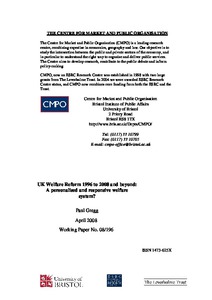UK welfare reform 1996 to 2008 and beyond: a personalised and responsive welfare system?
"The UK welfare system has undergone three very profound periods of reform of the post-war model laid down by Beveridge. The first was a move in the direction of (but never fully converged with) the Bismarkian model of a contributory social insurance model with time limited earnings related ben...
| Main Authors: | , |
|---|---|
| Institution: | ETUI-European Trade Union Institute |
| Format: | TEXT |
| Language: | English |
| Published: |
Bristol
2008
University of Bristol |
| Subjects: | |
| Online Access: | https://www.labourline.org/KENTIKA-19189326124919075089-uK-welfare-reform-1996-to-2008.htm |
| Summary: | "The UK welfare system has undergone three very profound periods of reform of the post-war model laid down by Beveridge. The first was a move in the direction of (but never fully converged with) the Bismarkian model of a contributory social insurance model with time limited earnings related benefits with a low value means tested social assistance safety net. This occurred slowly through the 1960s and up to the mid-1970s. The second phase started in 1979 and involved a dramatic move to curtail the social insurance entitlements and end all earnings related benefits. The result was a residualist low value means tested social assistance model, which ended both the Beveridge model and completely reversed the drift toward a European Bismarkian approach. Finally from 1996 a new model has emerged based on an activational welfare model with greater emphasis on incentives, support services and conditionality. As a direction of travel from the previous regime(s) this represents an increase in the engagement and support functions, increases in the (disciplinary) required activity functions combined with increased financial support for children and pensioners and personalised support services. The emerging model is far from completion and the final make up of the system remains uncertain. However, it bears strong similarities with developments in New Zealand and to a degree Australia and Canada. Within Europe the model most closely resembles a less generous version of the welfare systems in Denmark or Holland, which are sometimes referred to as embodying Flex-security. This evolutionary process of reform had some antecedents prior to 1996 but has really come to the fore since that date. This paper discusses reform in depth from 1996 and looks at its current direction of evolutionary change." |
|---|---|
| Physical Description: | 1 v. Digital |

